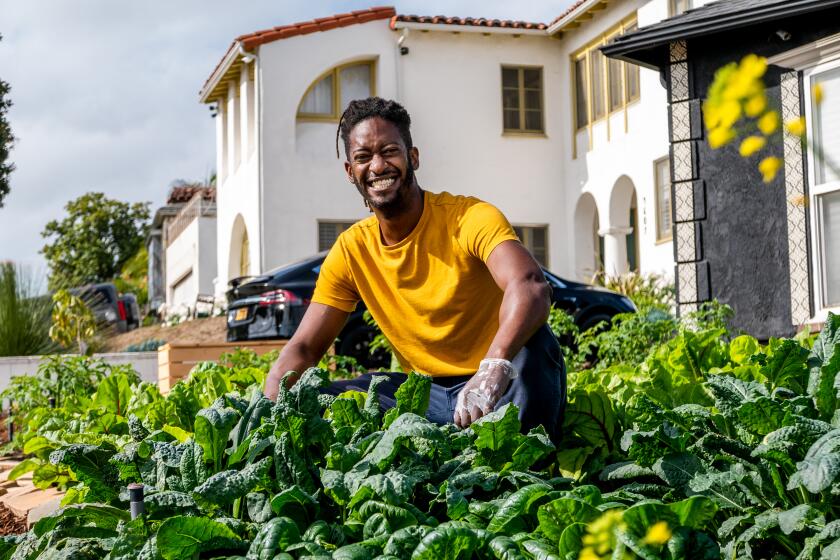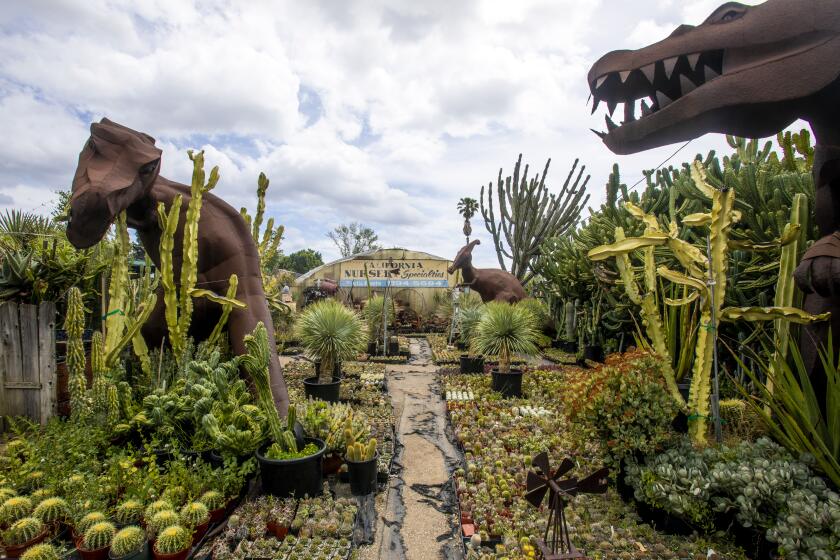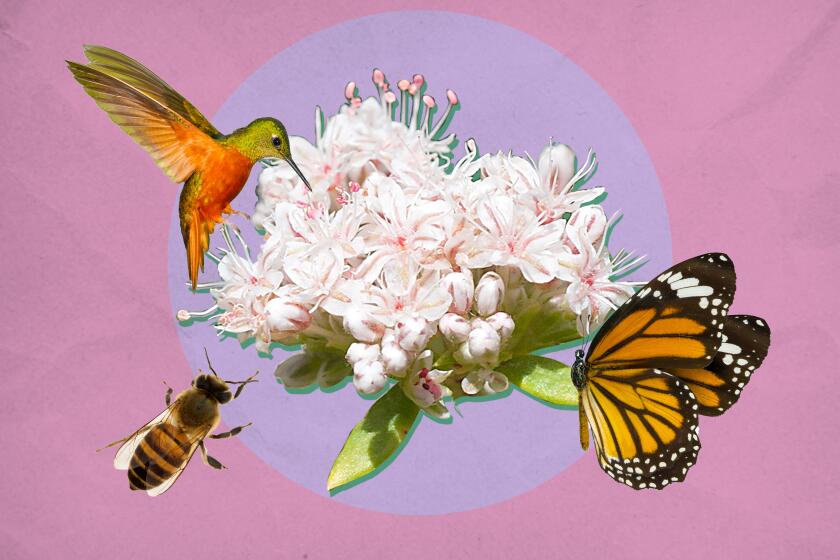You don’t need land to have a farm. Here’s how to grow food in pots

- Share via
This story is part of a package about growing food in containers. Learn how to grow vegetables, fruits and herbs in a contained space.
You don’t need land to be a farmer. With the right kind of sun, soil and containers, you can successfully grow food in a container on your balcony — or any other sunny outdoor location. But there are things to know if you’re going to successfully grow tomatoes for your salads, kale for your smoothies, blueberries for your cereal and mint for, well, everything.
We asked six garden experts for their advice for growing food in pots:
- Nicole Calhoun, owner of Artemisia Nursery in El Sereno
- Ron Finley, the self-proclaimed Gangsta Gardener, creator of the Ron Finley Project, TED talker and MasterClass garden instructor
- Lauri Kranz, urban farmer and owner of Edible Gardens LA, who grew all her food in pots when she lived on a canyon hillside that made in-ground gardening impossible. She also wrote the book “A Garden Can Be Anywhere” with her husband and farming partner, Dean Kuipers
- Ken Sparks — he’s Farmer Ken Official on Instagram — a garden consultant and urban farmer in East L.A. who just moved to Hemet to farm on a bigger piece of land
- Jo Anne Trigo, co-owner of Two Dog Organic Nursery in Mid-Wilshire, voted Los Angeles Magazine’s best organic nursery in 2020
- Christy Wilhelmi, creator of the Gardenerd website and author of “Gardening for Geeks” and the newly released “Grow Your Own Mini Fruit Garden”
First and foremost tip: You really can do this, even beginners — especially nowadays, when so many dwarf varieties make container gardening a reality for mere mortals. But with space at a premium, “you need to grow stuff you and the people around you like to eat,” said Finley.
You don’t need land to grow food. In our container farming series, these experts explain how to successfully grow veggies, fruit and herbs in containers on your patio, porch or balcony.
Here are nine ways to get started:
1. Assess your sun
Whether you’re growing on a balcony, patio or tiny porch, it is critical to know how much direct sun that space gets during the day. That’s because the plants we eat require a lot of sun to get their energy and nutrients, especially if they’re setting and ripening fruit.
“If you’re receiving at least four hours of direct sun a day, you can probably grow most vegetables and herbs,” Calhoun says. “If it’s less than four hours, it really limits your options for edible plants.”
Wilhelmi says you need at least six hours of direct sunlight for fruit trees. “Less than that, the tree may grow well but not produce fruit,” she said. “If it’s just four to five hours of direct sunlight, stick to strawberries and cane berries — like blackberries, boysenberries and raspberries.”
You want to know when the sun first hits your balcony or growing area and when it leaves, Wilhelmi said. Kranz recommends a sun study — taking photos every two hours on sunny days “and then email them to yourself with the time in the subject line,” she said. “You don’t even have to take them on the same day, but it really gives you a sense of how many hours of sunlight you have.”
Also, she says, remember that one part of the balcony or patio can get more sun than another part, so be sure you’re getting an accurate picture of the entire space. And remember those sun hours can change with the seasons, when the sun is higher or lower in the sky.
If your balcony gets lots of reflected sun from a nearby wall, that can help your plants, especially in the shoulder months when temperatures start getting cooler, but it doesn’t take the place of direct sunlight.
Strawberries and mint plants can maybe manage fewer than four hours of sun, especially if they get any reflected light, Calhoun said, “but generally, most crops need a stronger quality of light from direct sun.”
You can grow fruit on your balcony or other small space, as long as you choose the right varieties, keep them well-watered and fed and plant them in the right containers, with plenty of sun.
2. Check your weight
Before you lug up big bags of soil and pots, check with the building manager to see how much weight your balcony can manage, especially in older dwellings.
A few small pots on a balcony probably won’t be an issue, but if you plan to add wine half-barrels for fruit trees or a giant galvanized water trough filled with soil, be sure your structure can handle the weight. Remember to add your weight and that of others to the mix, plus any outdoor furniture, if you plan to enjoy your balcony garden with family and friends.
3. Where’s the water?
Deep, infrequent watering is best for in-ground gardens to encourage roots to grow deep into the soil, but that doesn’t work for container farming because plants in pots dry out more quickly than those in the ground. During really hot periods, you may have to water daily or even twice a day, so it’s important to know how you’ll get water to your plants.
Some modern apartments or condos have a water spigot on the patio or balcony. If your garden space isn’t plumbed for water, however, you’ll have to figure a way to move water from inside your house to the pots outside.
Several sources sell indoor hoses designed to attach to a faucet sink, but most commenters on a 2018 Reddit thread said these hoses tend to break or leak, causing a mess inside their homes. One balcony gardener suggested filling a large pail once a week in the tub and using a small wagon or dolly to wheel it from the bathtub to the patio. Then you can use a smaller dipper to water each plant.
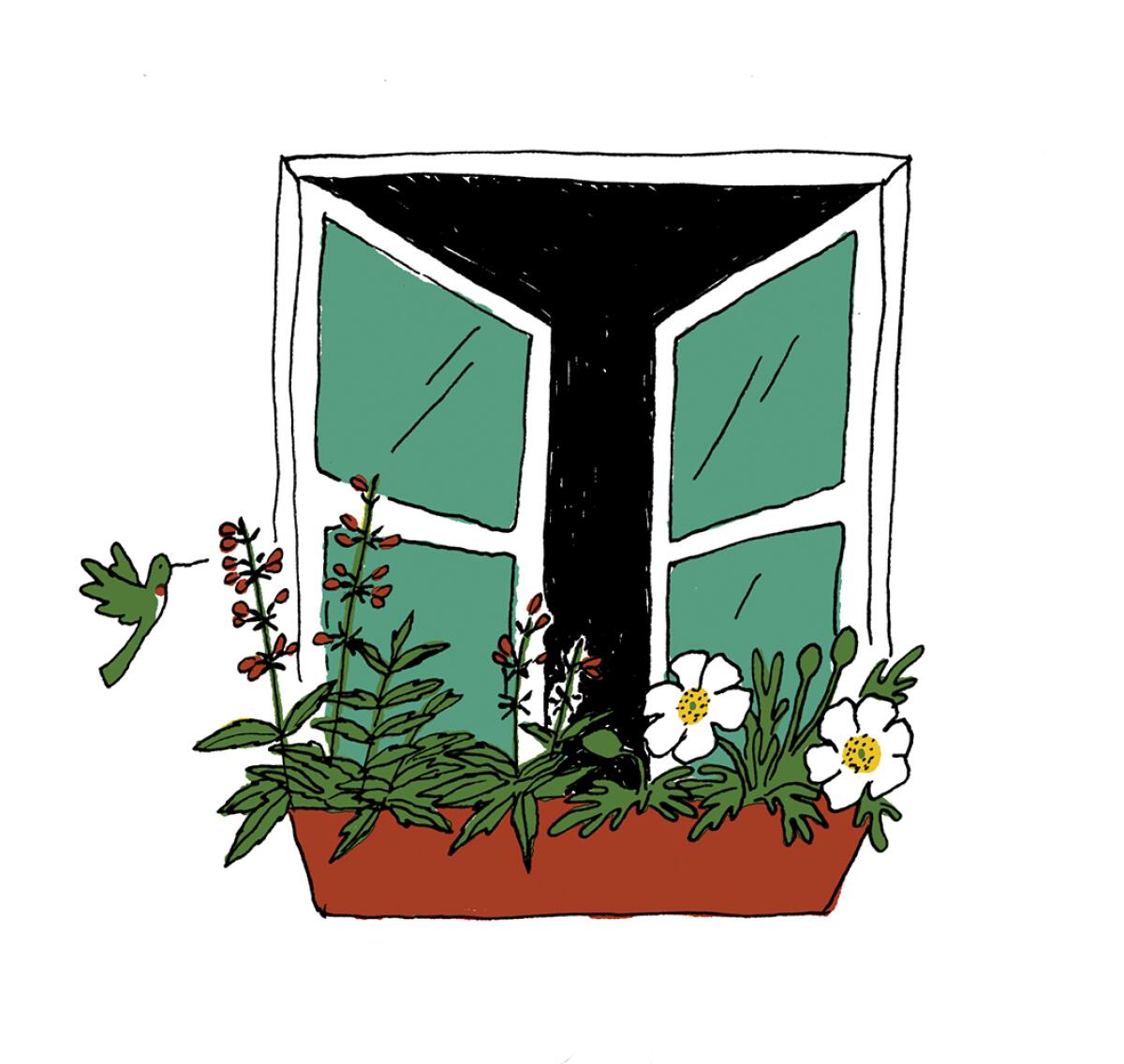
If you do opt to lug water, consider purchasing a couple of larger-size TubTrugs, lightweight, inexpensive food-safe plastic tubs with super-sturdy handles, available in multiple colors, to liven your balcony. You can even buy lids to keep out mosquitos and reduce evaporation. Keep one on the balcony and use the other to half fill with water so you can move it from the sink to the balcony without dousing your floor.
Kranz is a fan of old-fashioned watering cans because they allow you to gently and thoroughly water your potted plants, so it’s easy to tell when water starts draining from the bottom.
Why does it seem so hard to grow fresh herbs? Maybe you’re doing it wrong. We asked the experts for their secrets.
4. Don’t lose a drop
An important point about watering: Your landlord and downstairs neighbors probably won’t appreciate water dripping onto their balcony or staining the ground. The best way to avoid that is to water efficiently, says Kranz — make sure you slowly drench all the soil and not just blast water down the sides of the container. When you notice water running out of the bottom of your container, stop and move on to the next pot.
It’s also a good idea is to raise your pots slightly above the ground with half bricks, for instance, so the roots get plenty of air circulation, Finley said. Be sure, however, to keep the drain hole uncovered. Just rest the pot on two or three bricks around the edges so air can still circulate through the drain holes.
You can use saucers under your pots to catch runoff, but the experts warn against letting your plants sit in water. A little water left in the saucer won’t hurt, especially if it’s hot and dry, since the plant will suck it back up quickly, but be sure your plants aren’t left standing in water for long periods, since that will drown the roots.
Finley recommends lining the bottom of your containers with cardboard to keep water from running out too quickly. Make sure the pot has drain holes, he said, “and then line the bottom and about 2 to 3 inches up the sides. That way water won’t run out in a flood. The water will eventually drain out through the cardboard, but it stays a lot longer in the pot. It’s a way to conserve water and it’s good for the plant too, since the cardboard eventually dissolves.”
A final important note: Follow your nose. If your pot starts stinking, it’s a sign that water isn’t draining properly, Finley said. If that’s the case, you need to move the plant to another, better-draining pot quickly, before the plant drowns.
Jamiah Hargins wants microfarms to feed Los Angeles one frontyard at a time.
5. Size matters ...
Make sure your container has good drainage. Kranz recommends at least one 1-inch-diameter hole every 12 inches or so in the center of the container and, with large rectangular pots, holes in the corners too. If you choose a nontraditional container, such as a galvanized metal watering trough from a feed or hardware store, drill in drainage holes before you fill it with soil. (Note: Galvanized steel planters are popular now, but for growing food Kranz recommends only untreated wood, terra cotta or ceramic pots.
Container size depends on what you’re planting, but as a rule of thumb, you want your roots to have nearly as much room in the soil as the plants have above ground. That means pots at least 10 inches deep for most herbs and at least 24 inches deep and wide for tomatoes, peppers and young fruit trees.
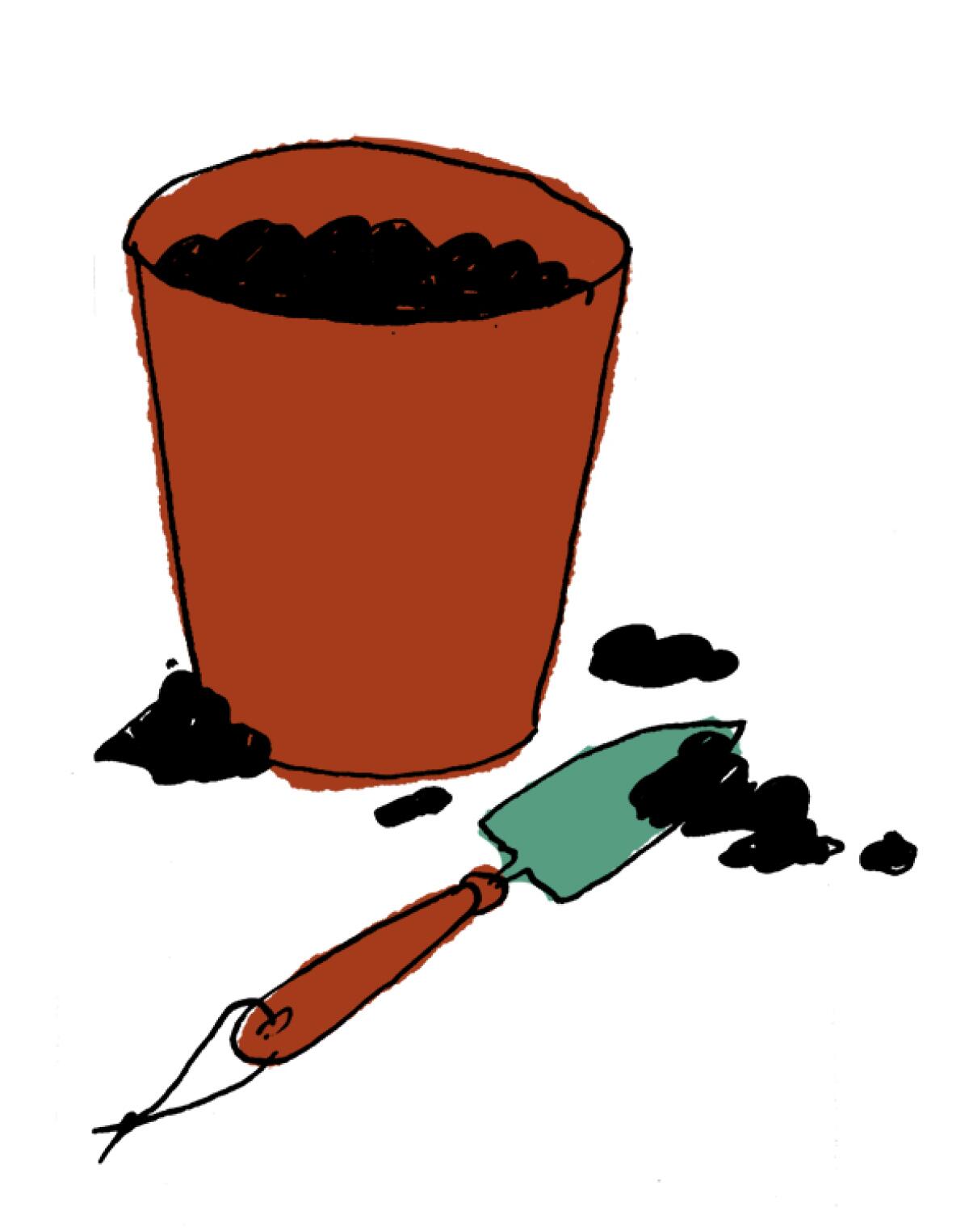
Talk to the people at your nursery to be sure you are getting a pot large enough for the plant you want to grow, and if it’s a tree, be sure to choose a pot that’s wider at the top than the bottom so you can easily transplant when the time comes. Either that, Wilhelmi says, or you’ll have to break the pot to get the plant out.
Many container gardeners practice companion planting: growing a vegetable in a large, deep pot with a few herbs and/or flowers along the edges, because the shallow roots of most herbs and annuals won’t interfere with the deeper roots of, say, a pepper or tomato. Just be sure the plants have the same water needs. For instance, rosemary and sage prefer dryer conditions than basil and tomatoes, so plant them separately.
Most herbs, including basil, thyme, parsley, chives, cilantro, marjoram and oregano, will do well with 10-inch-deep pots, says Calhoun, as will shallow-rooted greens like arugula and spinach, French breakfast radishes and scallions. Mint has shallow roots too, but tends to take over where ever it’s planted, so keep it in a separate container.
6. ... so does material
Terra cotta pots and fabric pots have pros and cons. Both are relatively inexpensive and porous, allowing roots to get plenty of air, which causes them to spread out in the pot instead of circling the sides. But all that breathability means the soil dries out more quickly in these pots than in less porous varieties, such as glazed clay pots or plastic, so be aware you’ll have to water more frequently during hot weather.
Nonetheless, Kranz insists on only natural materials for her pots, such as untreated redwood or cedar containers or terra cotta. “Just remember, anything you’re growing in, those materials will leach into the soil, into the food and, ultimately, into you,” she said. “If you’re growing organically, you don’t want to use any artificial materials like plastic or fiberglass to grow food in.”
Trigo, however, recommends EarthBox growing systems — rectangular boxes made from food-safe plastic that hold 2 cubic feet of soil and use a wicking system in the bottom to water the plants. Trigo sells these systems for about $70 (they’re about $15 less on Amazon) because she’s such a fan.
“I started with three and now I have 46,” she said. “They’re very efficient and space-saving — they handle one tomato plant, four cucumber plants, 10 kale or 12 to 16 pole beans.” You’ll still have to water daily during hot weather, she said, but you fill a receptacle instead of watering the entire pot, so that eliminates runoff and overwatering — the biggest killer of plants in pots.
Sparks likes a similar product, the Keter Easy Grow 31.7 gallon raised garden bed, because it has a self-watering reservoir that lets you know when it’s low. It’s so popular it’s currently out of stock at Amazon. Self-watering containers are great, Sparks said, “because it’s good for people who forget to water.”
The Cactus Ranch feels secret, special even, because as far as nurseries go it’s relatively unknown. During the week, the property is a wholesale nursery business, closed to the public. But on weekends it’s open to anyone.
7. Invest in good soil...
Think of soil the same way you think about the foundation under your house or the tires for your car, Wilhelmi said. “Soil is paramount, the most important part of growing something. If you buy crappy soil, you’re going to have crappy results.”
First, use potting soil in your containers, which is designed to drain well, and make sure it includes lots of organic matter, such as compost, Wilhelmi said. “My preferred soil is biodynamic, which means it is biologically alive with beneficial microbes.”
You will need to replenish the nutrients in your container soil more than than you would in the ground because you are constantly washing them away with each watering. All four experts advocate using organic fertilizers, either granular, such as Dr. Earth products that Calhoun likes, or liquid seaweed extract that Kranz dilutes in water and pours over the soil of her containers every couple of weeks.
8. ...and keep it fed
Most of our experts prefer adding organic amendments, such as compost and earthworm castings, as a top dressing to the soil to add extra nutrients to their plants, as well as mixing seaweed extract, compost or other organic amendments into their watering can every week or two. Sparks is a particular fan of Agrothrive, an organic liquid fish emulsion you mix with water. “I usually use liquid fertilizers because they allow the plants to take up [the nutrients] quicker,” he said.
Finley says it’s also critical to add a layer of mulch on top of your amendments to help retain moisture. “Mulch, mulch and more mulch now and forever,” he said. “You can add crushed-up leaves or wood chips, anything to protect your soil and preserve the water.”
With all fertilizers, be sure to read and follow the application directions since overfeeding your plants can be deadly. That’s why some growers prefer creating a “tea” of compost and water — or, in Sparks’ case, worm castings and water (he likes a pre-mixed organic “tea” called Vermis Terra) — and using that brew to water their plants every week or so, because it provides a regular but gentle dose of nutrients.
“Or you can just put a handful of compost in the pots from time to time,” Kranz said, “anything to give your plants a little nutrient boost.”
Trigo said she added a couple inches of compost and earthworm castings to her mature blueberry bushes, which grow in large pots, and they responded with abundant fruit.
Earthworm castings, by the way, “are basically the poop of the red wriggler worms, the good guys in our garden,” Trigo said. “As food passes through their bodies it becomes sort of supercharged and imparts all this fertilization and pest resistance. That’s why they call it the black gold of the garden, because it feeds the soil so beautifully.”
The new wave in landscaping is building habitat by growing native plants, but you don’t need a yard to promote biodiversity. Hummingbirds, butterflies, bees and other pollinators are happy to dine on native plants growing on balconies or patios.
9. Choose the right plants
Once you’re ready to plant, make a list of what you want to grow and then look for dwarf varieties designed for compact spaces. You want dwarf varieties, especially when it comes to fruit trees, so their roots have room to grow in the confines of a pot and your balcony or patio is not overwhelmed by one or two giant trees or plants.
Find a good local nursery and ask the people there for suggestions, Wilhelmi said. “This is why I tell people not to buy plants from a hardware stores,” she said, because the people who work in those big-box garden centers are rarely knowledgeable about the plants they sell.
Plus, smaller nurseries are more likely to carry specialty dwarf varieties.
For instance, Tomatomania — the beloved yearly, pop-up tomato market — offered more than a dozen varieties from the Dwarf Tomato Project , a national collection of breeders devoted to creating dwarf varieties of heirloom tomatoes to grow in containers or small spaces. (A welcome development, since most heirlooms can grow large enough to take over a patio.) Tomatomania has finished its pop-up sales for the year, but check with local nurseries to see what dwarf varieties they offer. Trigo also recommends Laurel’s Heirloom Tomato Plants in Lomita, which is open to the public on Sundays from 11 a.m. to 3 p.m. through mid- June and also sells a variety of plants by mail order online.
More to Read
Sign up for The Wild
We’ll help you find the best places to hike, bike and run, as well as the perfect silent spots for meditation and yoga.
You may occasionally receive promotional content from the Los Angeles Times.




